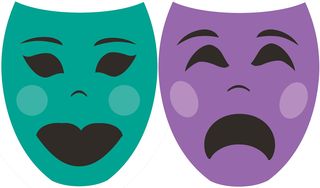Freudian Psychology
The Pleasures of Being in Disguise
What do Halloween costumes reveal and disguise?
Posted October 22, 2012

Whether masquerading at a costume party or spooking the neighbors, there is something strangely compelling about being in costume. Halloween is a rare occasion of pure playfulness for adults as well as children. Pick your mode of terror: witches, vampires, zombies, clowns, serial killers, serial killer clowns. Yet the playfulness may be a cover story for something deeper within us.
We know that Halloween rituals, such as wearing costumes, have their roots in the guising customs of Scotland and Ireland during the late 1900s and have strong connections to Celtic and Pagan harvest celebrations from centuries earlier. Halloween itself appears linked to the Celtic festival of Samhain, which is said to mean, “summer’s end.” There was a sense among the festival faithful in Scotland, Wales, and Ireland that the souls of the dead were more prevalent during this time and fears about succumbing to evil influences were commonplace. The wearing of costumes appeared to have begun as a way of protecting oneself from the potential harm of evil spirits and fairies.
Of course there were Christian influences as well. All Saint’s Day (or All Hallows Day, as it has been called) seems to have originated in the 7th century, though by the 9th century, Pope Gregory III had moved the day to November 1st, and had sanctioned the day as a celebration of holy martyrs. This is followed by All Souls’ Day, which has chiefly been celebrated by the Catholic church as a remembrance of the faithful who have recently departed. In any case, across both Christian and Pagan traditions, there has been a sense that the dead need to be prayed for and, perhaps, that the dead need to be feared. Was this the beginnings of the modern Halloween costume?
The idea of masquerading as someone or something else seems about as old as humanity itself and reaches across religious traditions and cultural practices. There were the masquerade balls of 15th century Europe–often celebrated in conjunction with Carnival. Masks have also been used ritually in African, Melanesian, Inuit, and American Indigenous cultures. Shakespeare was preoccupied with the idea that people are not always what they seem and often have contradictory impulses. In plays such as the Taming of the Shrew, The Merchant of Venice, and A Midsummer Night’s Dream, characters often used disguises to enact themes of human deception and ambivalence.
Shakespeare anticipated some of what Freud would fully develop: We are divided, contradictory creatures with an uncanny capacity, not only to disguise ourselves from other people, but to masquerade our own wishes and desires from ourselves. Our defenses are methods of disguise–ways of transforming what we find unbearable or transgressive into prosocial and meaningful ambition and fulfillment. This masquerading of desire ensures that there is always the potential of another version of ourselves.
Besides the obvious pleasures associated with Halloween, our donning of disguises may be a way of enjoying the possibility of being someone that we didn’t know we were or could be. Winnicott would probably say that wearing costumes is a transitional phenomenon, and the fact that children are so riveted by Halloween tells us something important about its essential playful nature. In this way, the eager-to-be-helpful gentleman at the hardware store gets to experiment with being a soul-stealing, Dark Prince of Pain. Or, we have the corporate CPA by day; blood-sucking, gothic vampire by night. Disguises help us wonder about what it would be like to be a version of ourselves that is more humorous, less empathetic, more surprising, or simply more interesting.
© 2012 Bruce C. Poulsen, All Rights Reserved


